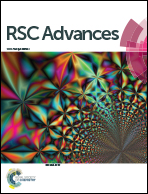Influence of metal ions (Zn2+, Cu2+, Ca2+, Mg2+ and Na+) on the water coordinated neutral and zwitterionic l-histidine dimer†
Abstract
The interaction of metal cations with mono hydrated, neutral and zwitterionic histidine dimer complexes are studied using the density functional theory (DFT-B3LYP) method in both gas and liquid phase. It is found that the metal interaction with histidine is governed by two types of bonds (I) N–Mn+ (Mn+ = Zn2+, Cu2+, Ca2+, Mg2+ and Na+), O–Mn+ bonds and (II) N⋯H–O and N–H⋯O hydrogen bonds. For both the liquid and gas phase, the coordination of metals with the nitrogen atom is strong in neutral systems, whereas the coordination with the oxygen atom is strong in the zwitterions systems. Among all the metal ions considered, the Cu2+ ion strongly coordinates with both the neutral and the zwitterionic forms of histidine dimer. AIM analysis indicates that the N–Mn+, O–Mn+ and hydrogen bonds are partially covalent and electrostatic in nature. The enthalpy of the reaction indicates that the reaction is energetically favoured and exothermic in nature. For all the metal complexes, pKa values decrease with the increase in hydrogen bond strength. Redox potential is high for the zwitterionic complex because of the transfer of electrons from the carboxylic group to amine moiety in all the metal complexes. From the MD calculations, we find that the backbone Mg2+ substituted complexes are stabilized around 0.9 nm, while for the other metal ions it is more than 1.0 nm. Kirkwood's potential indicates the presence of antiparallel dipole–dipole interactions.


 Please wait while we load your content...
Please wait while we load your content...